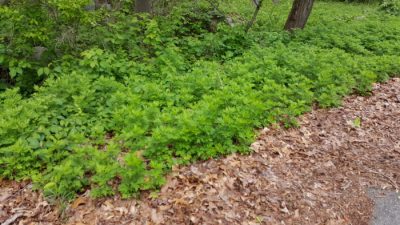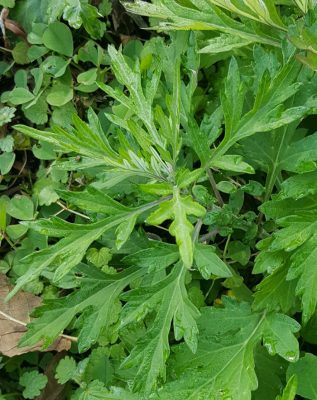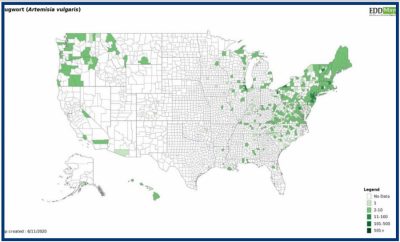Artemisia vulgaris
By Victoria Wallace, Alyssa Siegel-Miles, and Klaudia Sowizral, UConn Extension
Identifying Features
- OVERVIEW: Perennial. Height 2-5 ft. tall. Aggressive establishment and colonization in roadsides, right-of-way areas, and disturbed and uncultivated areas. Laboratory studies have found the presence of chemicals that could potentially suppress the growth of nearby plants.
- LEAVES: Alternate, papery, with large pinnate lobes. Green on upper surface, while undersides are covered with dense white to gray hairs. Foliage is aromatic, with a chrysanthemum or sage-like odor. Leaves emerging from ground have shallower and broader lobes, whereas leaves on mid and upper portion of the plant have lobes that are more linear and deeper.
- STEMS: Purplish-brown, branched, and covered with short hairs.
- FLOWERS: Inconspicuous flowers that lack petals. Occur in small terminal clusters (at the tops of stems). Yellowish, 2.5-3 mm long; composed of many disk flowers clustered onto a flat head.
- FRUIT: Single seed enclosed in a brown achene. Oblong with a narrow base, with small bristles at the tip.
- REPRODUCTION/SPREAD: Spread primarily by aggressive rhizomes (horizontal underground stems), which form large, fast-spreading patches. Can also reproduce by seed. Some seeds will sprout when bare, disturbed ground is available to form new colonies.



Habitat
Mugwort does well in partial to full sun and moderately dry to mid-moisture soils. It does not persist in wet soils, as it is susceptible to root rot. The plant is frequently found in high elevation areas, disturbed habitats, meadows, valleys, and roadsides.
Control
MECHANICAL CONTROL:
- To prevent seed dispersal, mow from early summer to mid-September, before seedhead production or before seed has matured. The first two weeks of September are the best time to mow. Cut immature seeds will not mature into viable seed. Mowing after seed has matured, from mid-fall through winter, is not recommended, as it would disperse mature, viable seed. If mowing after the second week in September, collect and bag mugwort cuttings, if possible.
- When possible, hand pulling very young plants in spring or early summer, before formation of rhizomes, may keep spread of populations in check and prevent establishment of new colonies. Scouting and prompt removal is essential.
- A heavy-duty landscape fabric or other impenetrable mulch can be used to smother mugwort. May require combination with other control methods to be successful.
- Since mugwort seeds sprout wherever there is exposed bare ground, stabilization and re-seeding of bare soil on roadsides with a grass cover will reduce establishment of mugwort populations.
CHEMICAL CONTROL: Follow label direction when using all chemical treatments.
- Timing of any chemical control is critical. Follow label instructions. The dense hairs on the mugwort leaf make herbicide penetration difficult. A surfactant may be needed.
- Foliar spray of glyphosate applied in late summer or early fall will suppress mugwort the following year, but not necessarily eradicate it. More selective herbicides, such as triclopyr and clopyralid, effectively control mugwort.
- Consulting with or hiring a licensed pesticide applicator is recommended.

EDDMapS. 2020. Early Detection & Distribution Mapping System. The University of Georgia - Center for Invasive Species and Ecosystem Health. Available online at eddmaps.org.
Refer to CIPWG’s Invasive Plant Management Calendar for more information.
Distribution
Common mugwort is found throughout much of the northeast, extending west to Minnesota and south to scattered areas in Florida. Many counties in Oregon and Washington have also reported large populations.
Other Facts and Background
Common mugwort is native to Europe and Eastern Asia. Mugwort was brought into North America as early as the 1600’s for medicinal purposes. It spread throughout the Northeastern U.S. as a contaminant on ships and nurseries. Mugwort pollen is a common cause of allergies and hay fever, wherever abundant. The plant is a common ingredient in many products, including insect repellents.
SOURCES:
- Chandran, R. (Reviewed 2019, June). Mugwort. West Virginia University Extension. https://extension.wvu.edu/lawn-gardening-pests/weeds/mugwort
- Connecticut Invasive Plant Working Group. (2018, October). Connecticut Invasive Plant List. https://cipwg.uconn.edu/invasive_plant_list
- Gadwa, S. N. & Mervosh, T. L. (n.d.). Artemisia vulgaris (Mugwort): Overlooked Infiltrator of Meadow Habitats. University of Connecticut College of Agriculture, Health, and Natural Resources. Artemisia Vulgaris (Mugwort): Overlooked Infiltrator of Meadow Habitats Authors: Sigrun N - DocsLib
- Missouri Botanical Garden, (n.d.). Artemisia vulgaris. Retrieved April 2021 from https://www.missouribotanicalgarden.org/PlantFinder/PlantFinderDetails.aspx?taxonid=256948&isprofile=0&
- New York Invasive Species (IS) Information. (2019, July 2). Mugwort. Cornell Cooperative Extension & SeaGrant New York. https://nyis.info/invasive_species/mugwort
Questions? Contact:
Vickie Wallace
UConn Extension
Extension Educator
Sustainable Turf and Landscape
Phone: (860) 885-2826
Email: victoria.wallace@uconn.edu
Web: ipm.uconn.edu/school
UConn Extension is committed to providing equal access and full participation for individuals with disabilities within all our programs and activities. Visit s.uconn.edu/accessibility for more resources. UConn is an equal opportunity program provider and employer.
©UConn Extension. All rights reserved.
Updated April 2021
  |